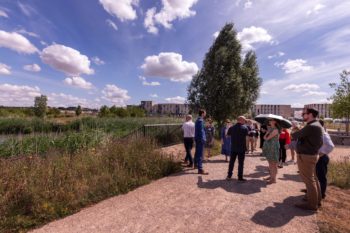Innovative rainwater water management project gathers pace
Over the last century, our urban areas have become increasingly impenetrable to rainwater, with paved surfaces preventing rainwater from trickling into the ground. Roofs and roads, patios and pathways all intercept rainwater and channel it into our drains and sewers, rather than back into the ground where it would eventually rejoin the water system.
Climate change is contributing to an increase in sudden and heavy downfalls, and the UK’s current drainage systems can quickly become overwhelmed in the event of a storm, or with heavy rainfall following a particularly dry few weeks.
In order to mitigate this, the Community-Centric Rainwater Management team, led by Thames Water, is trialling a potential solution in collaboration with homeowners, looking at installing rainwater storage technology, called Sustainable Drainage Systems (SuDS), in neighbourhoods. These systems can help to manage the flow of rainwater, controlling the run-off rate from hard surfaces, and reducing the impact of urbanisation on the water system whilst providing communities with rainwater for local use.
The team is looking at the idea of installing specially designed water butts in customers’ gardens. The idea is in exploratory stage, but these water butts could potentially serve a dual purpose; reducing the chance of sewers becoming overwhelmed and spilling into waterways, and storing rainwater for customers to use in their gardens. This latter function will become increasingly important with more frequent droughts leading to further hosepipe bans in future.
The Community Rainwater Management team are trialing this solution by challenging communities to test one method of distributed water storage. They hope this will reduce the impact of heavy rainfall on sewers and limit risk of overflow.
Nowadays, most people understand the importance and benefits of keeping materials out of landfill, however few are aware of how roads and paving can affect the water system, and therefore the environment. The shift towards consideration about how we can all help with responsible water is similar to the change that has happened with recycling. Through the project, the team want to explain and enhance this understanding, by directly working with individual communities and local issues.
In the long-term, installation of more decentralised rainwater storage has potential to mitigate flooding, limit stormwater overflows and all the while provide rainwater for local use in times of drought. This project will identify the drivers and benefits for local rainwater storage and support explore how to scale up such schemes in the future, bring benefits to individuals, communities and the local environment.




